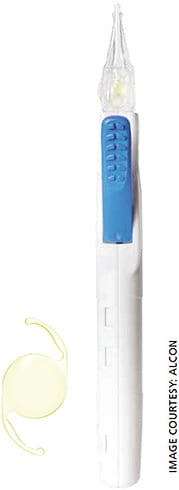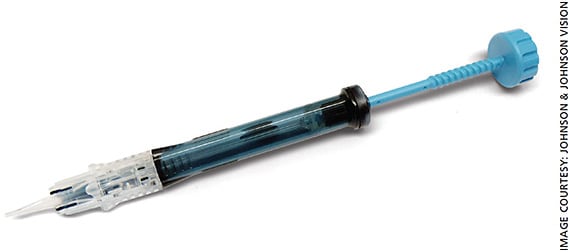If you were able to quickly start using a product that allowed you to perform surgeries more safely, made things easier on your staff and had a minimal learning curve, you would likely jump at the chance.
For cataract surgeries, preloaded IOL injectors seem to hit that mark.
“Anything that makes your day in the OR more reproducible, more streamlined and more controlled and predictable makes things better for you and your patient,” says Richard Tipperman, MD, Ophthalmic Partners, Bala Cynwyd, Pa., and attending surgeon at Wills Eye Hospital, Philadelphia. “Usually, the things that make procedures more reproducible, more predictable and more streamlined require more work.”
Preloaded IOL injectors, he notes, are “the exact opposite. It actually makes everything easier for the nursing staff, for the physician and ultimately for the patient as well.”
With a preloaded IOL injector, you and your staff no longer need to manually load an IOL into a lens inserter before inserting the lens into the capsular bag. Instead, the manufacturer preloads the lens into a delivery cartridge.
As vendors continue to refine these devices, you, your staff and your patients stand to benefit. Here are some of the key ways that the latest preloaders can benefit your practice.
PACKAGING
Even before the insertion of the IOL, cleverly designed packaging can benefit the surgical procedure. For example, the box of the Clareon IOL with AutonoMe preloader delivery system (Alcon) provides a thumb perforation to snap the container open, notes Dr. Tipperman.
As you slide out the lens, shelves contain the lens papers and documentation. This can be turned upside down and put on the circulating nurse’s desk or stand in a single motion. The lens and insertion system are in a sterile, easily opened pack that also can be turned upside down to easily deliver it to the scrub nurse’s working area. The AutonoMe system is scheduled to be available in the United States in the first half of 2022, for use with a monofocal lens.
Streamlined, single-peel packaging is also an advantage for the Simplicity preloader system (J&J Vision), says Sumit (Sam) Garg, MD, professor of ophthalmology and medical director at the Gavin Herbert Eye Institute, University of California, Irvine. Dr. Garg uses the TECNIS Monofocal, TECNIS Eyhance, TECNIS Toric II and TECNIS Synergy lenses (J&J Vision) with the Simplicity preloader system.

INSERTION/TECHNIQUE
For insertion, Dr. Tipperman uses a 2.2-mm incision and notes he has put a 28 D Clareon lens through 2.2-mm incision without struggling. The AutonoMe system allows him to use a one-handed technique through the use of a carbon dioxide cartridge that provides automated delivery. Previously, with a manual lens inserter, he would need to turn a screw to gradually drive a plunger to push the lens into the eye.
“You can do all that one-handed, so you can use your second hand to put countertraction through a paracentesis or 180° away from the incision,” Dr. Tipperman says. “It allows you to stabilize the eye so you’re not putting as much pressure on it to get the lens in the eye for the patient.”
During insertion, after the lens is in the eye, the physician can stop the plunger when it advances about 3 mm, notes Dr. Tipperman. As physicians perform their first cases, he says, it’s nice to stop it at about 3 mm and see how the lens is sitting in the eye in the capsular bag. Then, the physician can decide to extend it further, pushing down on the lever again to extend the plunger further and use that to manipulate the lens in the eye. The learning curve on the device, Dr. Tipperman notes, is “just about flat.”
Ease of insertion is also a benefit William B. Trattler, MD, Center for Excellence in Eye Care, Miami, Fla., found when using the IPure preloader injector system (BVI). “Both the one-piece and three-piece inject very smoothly and easily,” says Dr. Trattler. “It’s a very nice process for not only myself as the surgeon, but also the scrub tech.” He uses a 2.5-mm incision.

Dr. Trattler appreciates the consistency provided by having a preloaded IOL injector. “If you have an experienced scrub tech, the chance of an IOL not being loaded properly is low. The preloaded injector automates the process. If you’re doing higher volumes and working with multiple techs, having consistency is always very nice.”
Another major attraction for him was the IPure IOL’s optics. “It’s a high-quality acrylic optic with excellent optics,” he says. Neutrally spheric, the high-definition monofocal lens is designed to provide contrast and good nighttime vision.
Although Dr. Trattler uses the BVI monofocal lens, for toric cases he uses the TECNIS Eyhance preloaded toric IOLs (J&J Vision). “It’s a monofocal toric lens that provides enhanced range of vision compared to a standard monofocal toric,” he says.
The TECNIS Eyhance preloaded toric IOLs also provides improved image contrast in low light compared to other monofocals, and extended depth-of focus compared to the TECNIS 1-Piece, according to the company.
With Eyhance IOLs, the scrub tech can use either viscoelastic or balanced salt solution (BSS) within the inserter; for BVI, the tech uses only viscoelastic.
For Dr. Garg, the advance mechanism for the Simplicity provides a larger barrel and knob, making it easier to grip and inject the IOL compared to the previous J&J Vision iTec preloaded system. Dr. Garg also appreciates that you can use BSS instead of viscoelastic. For one thing, Dr. Garg notes, viscoelastic provides a little more resistance, and BSS can make the injection into the eye somewhat smoother.
Additionally, sometimes a case requires the use of more viscoelastic than a manufacturer provides. That means opening another package, as manufacturers typically don’t provide much extra viscoelastic, he points out. While using BSS or viscoelastic may make no difference to the patient, “the surgery center certainly cares, especially if you have to open up an extra OVD just to use a preloaded injector,” says Dr. Garg.
Using the preloaded IOL also allows Dr. Garg to do one final check on the IOL before insertion. He can look at the actual injector itself, which has a sticker with the lens power and characteristics. “Just for me to get one last glance at the lens power before I put it in the eye, that I’m double checking it myself, I really value that.”

Already a fan of the enVista platform (Bausch + Lomb), David A. Goldman, MD, founder, Goldman Eye, Palm Beach Gardens, Fla., moved to the SimplifEYE IOL delivery system (Bausch + Lomb) when it became available. He was attracted by the monofocal lens’ glistening-free, aberration-free design with its depth of focus and being “more forgiving” in situations such as lens dislocation, tilt and decentration. “Because of those features, I preferred the enVista lens. When the preloaded version came out, it was icing on the cake to be able to have a preloaded format.”
Dr. Goldman is also impressed by the SimplifEYE injector’s design. “The way it’s constructed is that once the IOL is deployed, a plunger comes out behind it which can be used to dunk the lens into the capsular bag. You don’t need the assistance of a second instrument, and that also saves time in the procedure.”

“The construction in general of the injector is favorable in that it’s easy to place within the lip of the corneal incision,” Dr. Goldman adds. “You don’t have to place it fully within the eye for it to work. You just want to keep pressure at the lip of your incision, and the injector platform does the rest. It doesn’t have a lot of resistance; it’s a pretty smooth delivery into the eye.”
TIME SAVINGS
Dr. Goldman sees time savings as a major benefit of preloaded injectors. “It saves the staff time in not having to load it. It reduces the risk of scratching or damaging the lens in the loading process, which can happen. And it makes everything flow more easily” because rather than looking away from him while he’s operating, the technician can focus on what he or she is doing and handing him instruments. The learning curve for the technicians is minimal, he notes.
Dr. Tipperman has noticed a similar benefit with his staff. In the past, notes Dr. Tipperman, folding and inserting an IOL into a manual system created a great deal of stress for nursing staff. A preloading device that ensures the IOL will be perfectly folded each time, “makes their day easier, and ultimately that makes my day easier. The real time savings and the real effort and energy savings come for the nursing staff.”
Without a preloader, even the best nursing staff could accidentally scratch a lens, Dr. Tipperman notes. This would normally result in an explantation, but preloaders prevent such an occurence. What’s more, “this allows the scrub nurse to be with me and following me the whole case,” rather than having to divert attention away from the procedure to focus on loading the lens.
Dr. Goldman estimates he saves about a minute per procedure using the SimplifEYE preloader, “because there’s about 30 seconds more that the technician would normally be loading the lens that’s saved, and then there’s 30 seconds on my side being saved in not having to get that second instrument to dunk the lens into the capsular bag and position it into place. When you have 30 surgeries a day, it makes a big difference.”
For Dr. Garg, if he’s using interoperative aberrometry (IA), having a preloader can help speed things along, he notes. In these cases, he asks for the lens after IA. And without a preloaded IOL, he has to wait for his staff to get the lens ready. With the preloaded Simplicity system, they don’t have to load the lens. In a busy OR, he notes, that can mean the difference between “being done on time or not being done on time or even adding an extra case at the end of the day.”
Even with these devices, Dr. Garg feels that there is still a role for knowing how to load a lens, especially for residents and younger surgeons. In case of a malfunction, for instance, the surgeon will need a backup. “I do think having that skill set of loading a lens is important.”
WHAT MATTERS MOST
Preloaded IOL injectors hold multiple advantages for staff and surgeons when performing cataract surgery. And although speed may be a big advantage, Dr. Tipperman offers perhaps a significant final reminder: “Cataract surgery is never a race; it’s all about quality results.” OM
Disclosures: Dr. Trattler is a consultant and speaker for BVI and J&J Vision; Dr. Goldman is a consultant for Alcon and Bausch + Lomb; Dr. Tipperman is a consultant for Alcon; Dr. Garg is a consultant to J&J Vision.








